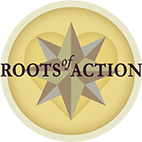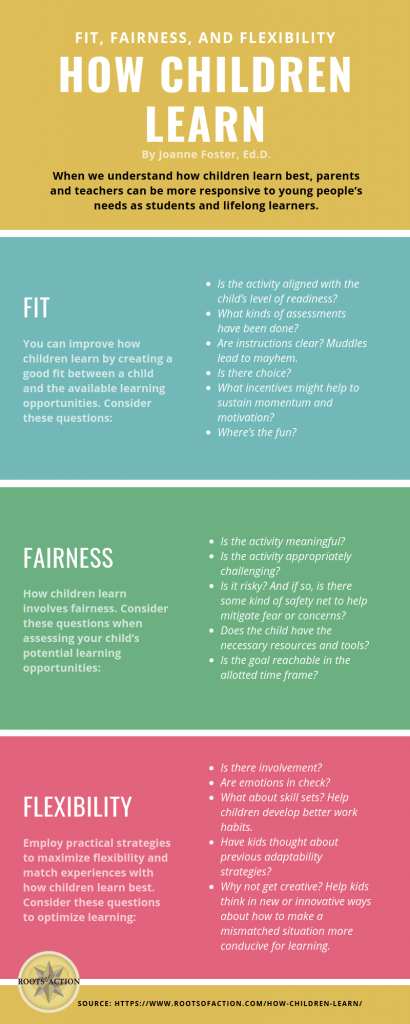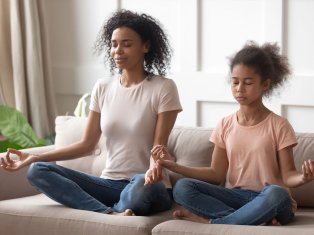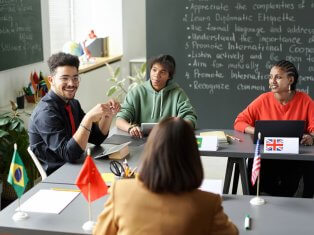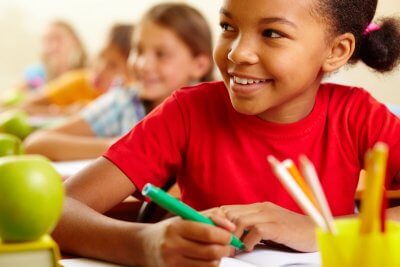
When we understand how children learn best, parents and teachers can be more responsive to young people’s needs as students and lifelong learners.
Not all children learn the same way. There are differences in how knowledge is acquired by each child, and this is an often-frustrating reality for parents who dream of their children’s success.
What if a child’s own perceived “best way of learning” is not well-matched to instructional methods offered at school? How can kids deal with this situation? And, how can parents help resolve these conflicts?
This article is about learning and mismatches, including questions and practical suggestions about school-related fit, fairness, and flexibility. It contains ideas for parents who want to better understand how children learn, and who wish to provide support. We’ll delve into how children and teens can build upon their own capacities and strengthen their resourcefulness—even when educational programs or expectations seem to be out of sync with kids’ preferred learning methods.
How Children Learn Through Experiences
Children need to have ample and appropriate learning opportunities—ones that are responsive to their individual needs and ways of learning. Those kinds of matches are the ideal.
Learning occurs in a variety of contexts and environments. How children learn is the result of dynamic interactions over time. These may be proactive, reactive, motivating, intense, moderately interesting, or creatively charged. Learning is derived from experiences, which differ from day to day, and from one individual to another.
Identifying a child’s academic requirements begins with awareness of what those requirements are, and involves ongoing assessment of what works, and what doesn’t. This entails communication, engagement, trial and error, review of outcomes, and more—including getting a clear understanding of what a child already knows, can do, and wants to do.
Sometimes children think they learn best in certain ways. Teachers may have a very different sense of what’s the most effective manner of instruction or programming. For example, it may involve more—or less—auditory, visual or kinesthetic approaches, based on the teacher’s ongoing assessment of the learning style of the student. These approaches may correspond in part, or not at all, to what a child believes is best.
Recent research about how children learn found that identifying a student’s preferred learning style “can be a hit-and-miss process, with no agreement between the assessment made by teachers and students.” Renowned psychologist and researcher Scott Barry Kaufman, shares his views about this study in Scientific American, where he notes the following:
“Teachers often think they know what’s best for the student, but this rarely matches with what the students think is the best thing for themselves. This is quite problematic, because it’s possible for students to fall between the cracks because their greatest strengths aren’t actually being recognized in the classroom environment.”
It’s imperative to recognize children’s areas of strength and weakness, and how children learn best in various situations. And, how a child learns (whether through play, study, inquiry, problem-solving, hands-on activities, collaboration, or some other means), is about building a foundation of knowledge. It entails developing skill sets (enhancing personal growth), and also nurturing the desire to put forth effort in order to go to the next level.
Learning is a mix of all of this! That mix can foster happily productive kids, empowering them to feel confident, confront new challenges, and advance in healthy ways.
Facilitating Stronger Networks for Learning
Learner-learning mismatches are often a reality for children. An educational mismatch is a lack of connectivity between how children learn—the best ways of understanding and doing—and accessible programming.
Educational mismatches are far too prevalent. These mismatches can short-circuit motivation, achievement, and confidence. They can lead to task avoidance and procrastination. They can also dampen a child’s spirit and become very frustrating. And, unfortunately, learning mismatches can occur from preschool right through college (and even into the workplace).
The good news is that children and adults are active agents in creating their own intelligence and success. They can develop greater self-awareness, reflect upon their aspirations, formulate plans, leverage resources, push themselves, and seek to find possibilities within the seemingly impossible. Learning opportunities materialize when they are discovered, wrangled, disassembled and reassembled, adjusted, or created.
Parents who discover mismatches between how children learn and how they are taught at school often feel concerned about this and may be unsure about how to help. But children can be proactive agents for change and, moreover, parents can support them in working toward improving their circumstances.
Many avenues are available for facilitating stronger, more effective networks for learning. These involve ensuring fit, fairness, and flexibility—three keys to facilitating a good match between children and potential learning experiences at school, home, or elsewhere.
About Fit
You can improve how children learn by creating a good fit between a child and the available learning opportunities. Consider these questions:
- Is the activity aligned with the child’s level of readiness? That is, not too easy or too hard. Not too boring or too complicated. Not too sedentary or too frenetic.
- What kinds of assessments have been done? A child’s learning needs are best determined by multiple measures, including ongoing assessments that are subject-specific, integrated into instruction, and individually responsive.
- Are instructions clear? Muddles lead to mayhem. There should be opportunities to ask questions and to clarify matters along the way.
- Is there choice? Kids become more engaged if they’re invited to select how they might approach something, or if what they’re learning either sparks or speaks to their curiosity.
- What incentives might help to sustain momentum and motivation? Encouragement? Reinforcement? Constructive feedback? Other people to share the load?
- Where’s the fun? Is there time built in for breaks and relaxation? For enthusiastic collaboration with friends? For play and exploration? For reflection and brainstorming?
About Fairness
How children learn involves fairness. Consider these questions when assessing your child’s potential learning opportunities:
- Is the activity meaningful? Is it realistic to expect that the child will want to accomplish it? Choice is integral to accomplishment.
- Is the activity appropriately challenging? A task should be manageable with reasonable effort.
- Is it risky? And if so, is there some kind of safety net to help mitigate fear or concerns?
- Does the child have the necessary resources and tools? Is the work technological? Project-based? Whatever it may be, are materials accessible?
- Is the goal reachable in the allotted time frame? Is there some wiggle room with respect to the child negotiating a longer timeline? Permitting shortcuts? Altering expectations?
About Flexibility
Employ practical strategies to maximize flexibility and match experiences with how children learn best. Consider these questions to optimize learning:
- Is there involvement? Encourage children to participate in planning their learning experiences to help ensure that they’re well suited.
- Are emotions in check? Children may need assistance and reassurance identifying and grappling with feelings like anger, shame, worry, disappointment, sadness, and so on. Kids can build upon their emotional well-being.
- What about skill sets? Help children develop better work habits relating to organization, time management, goal-setting, decision-making, communication, and self-advocacy. (Check out the many skill-building resources provided in the books Bust Your BUTS and Not Now, Maybe Later.)
- Have kids thought about previous adaptability strategies? Resilience can be a game changer! How have kids managed to circumvent or overcome difficulties in the past? What tactics or ideas have worked for them before? Who have they enlisted to help? Reflecting upon past successes provides a window into possibilities for the present and the future.
- Why not get creative? Help kids think in new or innovative ways about how to make a mismatched situation, task, or environment more appealing, interesting, or conducive for learning. Creativity fuels learning and can foster expression, boost productivity, and help people overcome a challenge.
Optimizing How Children Learn
Realistically, teachers cannot tailor curriculum to all children’s needs. However, parents can pay attention to and foster their child’s ability to learn.
It’s important to appreciate your child’s development, learning differences, and personal challenges. This involves staying attuned to their cognitive ability, intellectual curiosity, sociability, goal-setting, experiential factors, emotional literacy, and more.
A key spin on resourcefulness is to encourage children to be respectfully assertive about their learning preferences, to make reasonable requests, and to find and take advantage of what is available. Resources exist at school, through home-based initiatives, online, within neighborhoods, and beyond.
Learning options may involve mentorships, cross-cultural experiences, career explorations, competitions, leadership possibilities, volunteerism, and community service. There are arts programs, library offerings, outdoor conservation centers, clubs, book groups, and more. Resourcefulness can be impactful and enriching on many levels, with short, medium, and long-term benefits.
Consider this old Chinese proverb: “Pearls don’t lie on the seashore. If you want one, you must dive for it.” Parents can encourage children to participate proactively in ensuring their own best education, to take initiative, and to get involved in co-creating learning experiences so they will be meaningful and motivating.
Kids can start by thinking about the ideas in the above-noted bulleted lists of questions, and by communicating their feelings and thoughts about fit, about what’s fair, and about how they might be as flexible as possible!
How Children Learn – Infographic
Published: January 19, 2019
